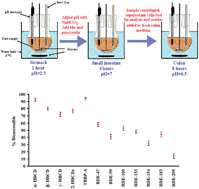In vitro assessment of the bioaccessibility of brominated flame retardants in indoor dust using a colon extended model of the human gastrointestinal tract†
Abstract
An in vitro colon extended physiologically based

Maintenance work is planned for Wednesday 1st May 2024 from 9:00am to 11:00am (BST).
During this time, the performance of our website may be affected - searches may run slowly and some pages may be temporarily unavailable. If this happens, please try refreshing your web browser or try waiting two to three minutes before trying again.
We apologise for any inconvenience this might cause and thank you for your patience.
* Corresponding authors
a
Department of Analytical Chemistry, Faculty of Pharmacy, Assiut University, 71526 Assiut, Egypt
E-mail:
mae_abdallah@yahoo.co.uk
Fax: +20 88 2332776
Tel: +20 88 241 1009
b Soil Research Centre, School of Human and Environmental Sciences, University of Reading, Reading, UK
c Division of Environmental Health and Risk Management, School of Geography, Earth and Environmental Sciences, University of Birmingham, B15 2TT, Birmingham,, UK
An in vitro colon extended physiologically based

 Please wait while we load your content...
Something went wrong. Try again?
Please wait while we load your content...
Something went wrong. Try again?
M. Abou-Elwafa Abdallah, E. Tilston, S. Harrad and C. Collins, J. Environ. Monit., 2012, 14, 3276 DOI: 10.1039/C2EM30690E
To request permission to reproduce material from this article, please go to the Copyright Clearance Center request page.
If you are an author contributing to an RSC publication, you do not need to request permission provided correct acknowledgement is given.
If you are the author of this article, you do not need to request permission to reproduce figures and diagrams provided correct acknowledgement is given. If you want to reproduce the whole article in a third-party publication (excluding your thesis/dissertation for which permission is not required) please go to the Copyright Clearance Center request page.
Read more about how to correctly acknowledge RSC content.
 Fetching data from CrossRef.
Fetching data from CrossRef.
This may take some time to load.
Loading related content
